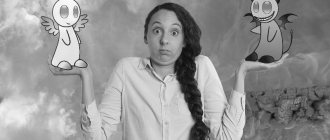In contrast to classical psychoanalysis, the behavioral approach is aimed at the external and visible actions of a person, as well as their results. In behavioral therapy, the patient is taught to help themselves. In this form of psychotherapy, it is assumed that everyone is capable of learning new behaviors.
Motivation is especially important since homework also needs to be done. When treating mental disorders, fears, harmful behavior and unfavorable attitudes towards problems are reduced. The behavioral approach also integrates aspects of psychoeducation that provide patients with knowledge about their illness.
In this article:
When is a behavioral approach usefulWhat happens in behavioral therapyWhen and for how long is behavioral therapy used
Dictionary interpretation
First of all, we need to clearly formulate the essence of the behavioral approach, its meaning. So, this term refers to the area in psychology that studies the behavior of people as a species and animals. It is assumed that all actions are based on reflexes, as well as on various reactions to certain factors coming from the environment. An important criterion for an individual’s behavior is his personal history, that is, life experience. It alternates between rewards and punishments, motivation and disappointment - they determine the further reaction to specific events. Often the behavioral approach in psychology is called behaviorism - the term comes from the English word Behavior - “behavior”. It is worth noting that behaviorists - scientists who deal with this area of psychology - understand that a hereditary factor can also influence an individual’s behavior. But at the same time, they place greater “responsibility” for certain actions on the environment.
Basics of Behavioral Psychology
Behavioral psychology was born in the United States and dominated other fields of psychology in the first half of the 20th century.
J.B. Watson is considered the founder of behavioral psychology. In his report published in 1913, he writes that from the point of view of behaviorism, psychology is an objective experimental branch of the natural sciences, and the goal of behaviorism is to predict and control human behavior.
Behavioral psychology
“Knowing how to achieve control through incentives, without resorting to yelling and coercion, makes life easier for everyone, educator and learner alike.”
Karen Pryor
Introspective psychology, which is considered biased, is rejected by behaviorism. Behavioral psychologists believe that objective conclusions can only be drawn by studying observable facts (behavior) that can be measured and quantified.
Purpose of Behavioral Psychology
The Behavioral Manifesto, published by J. B. Watson in 1913, marked a turning point in psychology. Behaviorism became its main direction due to its pragmatism.
The idea of behavioral psychology is to guide and change people's behavior so that they can transform their lives. To implement this ambitious project, you need to know the laws of behavior, predict and control it.
That is, in order to be able to influence the result, you need to know what causes it.
Founders
While studying the history of this area of psychology, at the same time we will get acquainted with its representatives. The behavioral approach began to emerge in the second half of the 19th century, after such areas of science as depth psychology and the law of effect (the latter explains how behavior changes due to reinforcement) became widely known. The “father” of this term and its essence was the American scientist John Brodes Watson. His methodological behaviorism suggested that it is worth paying attention exclusively to signals entering a person’s consciousness from the external environment. At the same time, his thoughts and feelings can be ignored, since they do not affect behavior. Soon this theory began to be challenged by Burres Frederick Skinner, who realized that feelings and thoughts are controlled by the same areas of the brain as external stimuli, therefore, they are also impetuses for certain reactions. His version came to be called radical behaviorism and became more widespread.
It is interesting to know that Watson was supported in his judgments by our scientist Ivan Petrovich Pavlov - we all know about his dogs and their reaction to the “bell”.
Development of the theory and practice of behaviorism
Behaviorism is a branch of psychology that focuses on behavior. The first attempts at scientific understanding arose on the basis of mechanistic determinism, in whose categories behavior was interpreted in accordance with the nature of the interaction of physical bodies. The theory of evolution in biology (C. Darwin) made it possible to explain the purposefulness of the behavior of living beings, which stimulated the development of objective methods for studying behavior in the unity of its external and internal manifestations. On the basis of biological determinism, the doctrine of the higher nervous activity of animals was developed, synonymous with I.P. Pavlov considered behavior. Behaviorism opposed behavior and consciousness and believed that the object of psychology is only behavior, which is reduced to a set of motor reactions to external stimuli.
One of the pioneers of the behaviorist movement was Edward Thorndike (1874-1949). He called himself not a behaviorist, but a “connectionist” (from “connexia” - connection). Researchers and their concepts, however, should be judged not by what they call themselves, but by their role in the development of knowledge. Thorndike's work opened the first chapter in the annals of behaviorism.
Thorndike greatly expanded the field of psychology. He showed that this goes far beyond consciousness. Previously, it was assumed that beyond these limits the psychologist could only be interested in unconscious phenomena hidden in the “depths of the soul.” Thorndike decisively changed his orientation. The field of psychology turns out to be the interaction between the organism and the environment. Old psychology argued that connections are formed between the phenomena of consciousness. She called them associations. In early physiology, it was argued that connections were formed between the stimulation of receptors and the response movement of muscles. They were called reflexes. According to Thorndike, connection is the connection between a response and a situation. Obviously this is a new element. In the language of later psychology, connection is an element of behavior. True, Thorndike did not use the term “behavior.” He talked about intelligence, about learning.
Thorndike, more than anyone else, prepared the ground for the emergence of behaviorism. At the same time, as already mentioned, he did not consider himself a behaviorist; in his explanations of learning processes he used concepts that behaviorism later called for to be banished from psychology. These were, on the one hand, concepts related to the sphere of the psyche in the traditional sense (in particular, the concepts of states of satisfaction and discomfort experienced by the body when establishing connections between motor reactions and external situations), and, on the other hand, concepts from neurophysiology ( in particular, the "law of readiness", which, according to Thorndike, involves changes in the ability to direct impulses). Behaviorist theory prohibited the behaviorist from dealing with both what the subject experiences and physiological factors.
Many versions
The original theory of the behavioral approach to the study of the reactions of living beings to certain factors has become a real resonance in the world of psychology. No matter how cheesy it may sound, everyone who was not too lazy was involved in the study of this topic, and therefore the most ridiculous judgments were sometimes put forward. But among them, from time to time, very worthwhile thoughts surfaced, which later turned into full-fledged types of behavioral approach, or variations. Essentially, each of them is telling the truth - it's like comparing the judgment of Watson and Skinner. Therefore, every modern psychologist decides for himself which theory is closer to him and is guided by it. We suggest that you familiarize yourself with each of them in turn.
Radical behaviorism
The second and much more significant theory of the behavioral approach, also proposed by an American named Skinner. Most likely, it became a winner precisely because of its versatility and a kind of “psychological cosmopolitanism.” In other words, Skinner believed that it is worth taking into account not only stimuli from the environment that “affect” a person, but also his feelings and thoughts that overcome him at a particular moment in time. Equally important is experience - both negative and positive. The hereditary factor was also taken into account, because at the genetic level, representatives of certain types of living organisms (including people - here we had to distinguish by race and culture) also have specific beliefs that influence behavior. This behavioral approach has become universal and is probably still the most widespread and correct in psychology.
20.1. Behavioral counseling theory
Behavioral counseling is based on the behaviorist model of humans. Behavioral theory places particular emphasis on the strong influence of the environment on the formation and maintenance of behavior.
In behavioral counseling, there are approaches based solely on stimulus-response relationships and approaches that take into account cognitive mediating variables. The behaviorist model is a set of experimentally developed learning principles41
The experimental activities of the outstanding Russian physiologist I.P. have had a fundamental influence on the behavioral approach to counseling for a long time. Pavlova. As a result of his experiments, Pavlov built a scheme for developing a conditioned reaction. Learning a conditioned response using Pavlov's method came to be called classical, or respondent, conditioning. Pavlov and his colleagues investigated the nature of many other physiological phenomena, such as conditioned inhibition and stimulus generalization.
Psychological behaviorism
For the first time, under the influence of a scientist named Arthur W. Staats, the behavioral approach becomes not just a theory supported by a small number of experiments, mostly performed on animals, but a half-practical field of knowledge. In terms of theory, Staats developed a kind of time-out system, that is, a break from certain factors/thoughts that could influence human behavior, as well as a system of tokens - rewards. Experiments have already been carried out on humans, mainly on children with mental disorders. This experience allowed us to reach new heights in the field of education, cultural and social development, as well as the prevention of many nervous disorders.
Examples of CBT exercises
Cognitive techniques are divided into several groups. The exercises of the first group are aimed at identifying negative attitudes. For example, keeping a diary of thoughts and then evaluating them. The exercises of the second group are aimed at challenging the identified attitudes. For example, a person might make a list of the pros and cons of a particular attitude. The exercises of the third group are aimed at correcting ideas. For example, by repeating a positive attitude it is possible to weaken the influence of a provoking factor and eliminate a maladaptive stereotype. Exercises of the fourth group are aimed at increasing the effectiveness of therapy, for example, identifying hidden motives for destructive behavior.
To schedule a consultation with a specialist, call or fill out the application form on the website.
You can also contact us using instant messengers:
[ht-ctc-chat number=79643424702 style=8 call_to_action=»WhatsApp» ]
From study to application
After Staats demonstrated his experiments to the world, the basics of the behavioral approach immediately became the basis for adjusting the behavior of various groups of individuals. In essence, theory was turned into practice - and nothing more. In the course of such manipulations, a new area of practical knowledge emerged - applied behavior analysis. It is based on the principles of radical behaviorism, with the help of which reactions to certain stimuli in a particular person or group of people are corrected. These are the so-called behavioral approach techniques, of which there are countless. Let's list some of them. So, using radical behaviorism, you can control and change:
- Autism spectrum disorders.
- Conservation of natural resources.
- Physical education and a healthy lifestyle.
- Language learning.
- Medicine.
- Parenting.
- The fight against drugs.
- Attitude towards animals.
- Leadership and management sphere.
In a word, the technique of radical behaviorism can be applied absolutely everywhere, and the influence can be exerted both on a specific individual and on a group of people.
When is a behavioral approach useful?
Photo by cottonbro: Pexels
Behavioral therapy can be used for a variety of mental illnesses, as well as in couples therapy:
- ADHD: Attention-deficit/hyperactivity disorder occurs primarily in children, but can be treated with psychotherapy in adulthood.
- Mood disorders: eg depression, mania, bipolar disorder. In this case, the main symptoms are changes in mood towards depression or exaggerated elevation of mood. In bipolar disorder, the two phases often alternate.
- Stress and adjustment disorders: for example, post-traumatic stress disorder. Caused by traumatic experiences or constant stress. This results in, among other things, depression, anxiety and decreased social activity.
- Dissociative, conversion and somatoform disorders: characterized by loss of normal memory, awareness of identity and immediate sensations, as well as loss of control over body movements. In somatoform disorders, patients complain of physical symptoms that are purely psychological and cannot be treated.
- Eating disorders: for example, anorexia nervosa, bulimia nervosa. This is deliberate or persistent weight loss (anorexia) or excessive weight control that is associated with overeating and subsequent vomiting (bulimia).
Cognitive behavioral psychotherapy
- Neurotic disorders: for example, social phobia, panic disorder, obsessive-compulsive disorder, agoraphobia. In phobic disorders, it is usually harmless situations or objects that cause fear in the patient. Panic attacks in the context of panic disorder are not situation-specific and unpredictable. Obsessive-compulsive disorder is characterized by repetitive, obsessive actions and thoughts.
- Personality disorders: eg, borderline personality disorder, paranoid personality disorder. There are deviations in perception, thinking, feeling and in relationships with other people.
- Psychosomatic diseases: for example, headache, high blood pressure, asthma. With these conditions, the body and mind work together in such a way that treating the physical symptoms alone is not enough.
- Psychotic illnesses: for example, schizophrenia, schizotypal and delusional disorders. These diseases are characterized by impaired thinking and perception, a violation of the sense of individuality, uniqueness and freedom of choice. This occurs, for example, in such a way that victims believe that others understand their thoughts or that they are under the control of others.
And this is not a complete list of what a behavioral approach can help with.
Methodology
This section is also called behavioral therapy and is very often used in practical psychology to correct certain human reactions and habits. The therapy is based on conditioning and learning. By following certain methods of the behavioral approach, you can completely change the map of your own actions and actions, and become a different person. Thanks to these techniques, they get rid of bad habits, acquire new skills and inclinations, and begin to look at the world in a new way and interact with it differently. The methodology was first successfully put into practice by Watson's students at the end of the 19th century. They taught children not to be afraid of animals. The following techniques were involved in this process, which remain relevant to this day.
When and for how long is behavioral therapy used?
The duration of behavioral therapy depends on clinical symptoms and the duration of psychological complaints. In cases of severe mental illness, treatment may last several years. Joint supervision by a specialist (psychiatry, neurology, etc.) is especially recommended for psychiatric and psychosomatic patients, since most patients require medication support.
What to consider after behavior therapy
After completing behavioral therapy, follow-up measures should be followed during which you need to update your newly learned behaviors and attitudes.
Photo by vishnudeep dixit from Pexels
Continue to follow the action plans that have been learned and contact your therapist or doctor immediately if old behavior patterns return or your mental health worsens.
What can contribute to the success of the behavioral approach?
The patient must have a positive attitude towards the behavioral method and a desire to learn new behavior patterns or change old ones. Active participation in treatment is also important, including creating action plans and doing exercises. Work with your therapist to identify treatment goals, intermediate goals, and alternatives. Additional treatment from specialists is often required, which is also worth taking advantage of.
Learning and Assimilation
An unshakable foundation that allows you to change your behavior as much as possible or get rid of a bad habit. The method is based on a model - it can be an idol, a figurine or symbol, a film, a story, an action or a staged performance. The type of illustrative example is chosen depending on who exactly the psychologist is working with. Let’s say a child starts smoking, but at the same time becomes interested in the work of specific musicians, and they, in turn, support a healthy lifestyle. The psychologist reminds the teenager that even his idols do not do this, and he, imitating the model, weanes himself from the bad habit. Similarly, you can accustom a person to something, for example, to study more or learn a foreign language.
It is important to note that in this work it is necessary to use a reward system. In the standard version, for children these are sweets, for adults - valuable things or money.
Unlearning
A much more stringent method in behavioral therapy, which is based on the explicit avoidance of one or another factor that should be gotten rid of. Using the same system of rewards for positive actions and a system of punishments and fines for negative ones, a person gradually begins to lose the habit of doing what he should not do. The most interesting thing is that the unlearning technique can be effective not only on the mental or psychological level, but also on the physical. A clear example from the first area is alcoholism. When a person begins to drink alcohol, the process should be accompanied by an extremely unpleasant odor that causes vomiting. Gradually, alcohol will begin to be associated with just such negative feelings. An example from physiology is enuresis. A special device is attached to the patient, which reacts to the appearance of urine. At the same moment, the patient awakens and realizes that he is urinating.
Elimination
A very effective method that has become widely known as systematic desensitization. Its essence is that fear or phobia is suppressed by a state of relaxation. Let's say a person is very afraid of heights and, being on the roof of a skyscraper, begins to experience not only conscious anxiety. His body begins to react to fear: muscles contract, pulse quickens, blood pressure rises. So the body and consciousness unite in a state of horror, and the person finds himself completely paralyzed in front of his phobia. If you break this connection, the fear will dry up, and this can be done either by teaching your consciousness not to notice the height (which is almost unrealistic, because it decided to be afraid of this phenomenon), or by relaxing physically. The second option is simpler to implement. Therefore, a person is deliberately placed in the environment where he feels the greatest anxiety, and at the same time, with the help of medications or certain psychological manipulations, his muscular corset is relaxed and his cardiac indicators are reduced. Gradually the fear completely disappears.
Chapter 2. BEHAVIORAL DIRECTION
The behavioral direction in psychocorrectional work originates from the works of D. Wolpe and A. Lazarus (mid-50s - early 60s), although its roots go back to the behaviorism of D. Watson and E. Thorndike.
This direction is based on three classical psychological trends:
1. Works by D. Volpe, A. Lazarus, based on the ideas of I.P. Pavlova and S. Halla.
2. B. Skinner's theory of operant learning.
3. Cognitive learning theory.
Currently, three main trends coexist in behavioral psychocorrection:
1. classical conditioning,
going back to the experimental traditions of I.P. Pavlova.
2. Operant conditioning
associated with the name of B. Skinner and his behavior modifications.
3. Multimodal programming.
1. Classical theory of conditioned reflexes I.P. Pavlova was the foundation on which the modern building of behavioral correction was built. Based on the principles of classical conditioning, such behavior correction techniques as the aversive conditioning technique, stimulus control technique, etc. have been created.
I.P. Pavlov was the first to answer the question of how a neutral stimulus can become a conditioned stimulus
and cause the same reaction as the unconditioned reflex, which occurs automatically. I.P. Pavlov showed that the formation of a conditioned reflex is subject to a number of requirements:
.adjacency -
coincidence in time of indifferent and unconditioned stimuli with
some advance of the first; . repetition -
repeated combination of indifferent and unconditioned stimuli.
Thus, one of the ways to control behavior is to control the presentation of stimuli that cause a certain reaction, as well as to organize and control the external environment. By organizing the external environment, it is possible to shape a certain human behavior in a certain way.
2. The theory of operant conditioning is associated with the names of E. Thorndike and B. Skinner. In contrast to the principle of classical stimulus-response (S→R) conditioning, scientists have developed the principle of operant conditioning of response-stimulus (R→S), according to which behavior is controlled by its results and consequences. This suggests a possible way to influence behavior through influencing its results.
When using operant methods, the results of behavior are controlled to influence the behavior itself. Therefore, special importance is attached to the stage of functional analysis,
or behavioral diagnostics. The task of this stage is to determine the reinforcing significance of the objects surrounding the client, establishing a hierarchy of their reinforcing power. This can be done through direct observation of human behavior and establishing a connection between the frequency and intensity of the behavior exhibited (dependent variable) and the objects and events occurring in the environment at that time (independent variable).
Operant methods can be used to solve the following problems:
· the formation of a new behavioral stereotype that was not previously in a person’s behavioral repertoire (for example, the behavior of a self-affirming type in a passive child, elements of joint play in a shy child, etc.), to form such behavior, various strategies are used - “shaping”, “coupling” , “fading”, etc.;
· consolidation (strengthening) of a socially desirable stereotype of behavior already existing in the client’s repertoire. Stimulus control, positive and negative reinforcement are used to solve this problem;
· reducing or extinguishing unwanted behavior. Achieved using methods of punishment, extinction, satiation, deprivation of all positive reinforcements, response assessment;
· maintaining a desired behavior pattern in normal (natural) conditions.
3. Multimodal programming, or multimodal behavioral correction. In this direction, the central place is given to the impact on the holistic organization of the individual. Within this newest direction (A. Lazarus, A. Bandura, T. Neilans, etc.), which includes cognitive-oriented modeling techniques and behavior formation, programs of self-regulation, cognitive self-regulation, and cognitive behavior modification have been developed.
In recent years, this movement has found more and more supporters. One of the latest achievements of behavioral psychotherapy is the relief of post-traumatic syndrome using bilateral saccodic eye movements. Discovered in 1987 (F. Shapiro), this method has proven itself in working with Vietnam War veterans, victims of violence, etc.
At the head of modern behavioral theories of man is the idea that man is a product and at the same time a producer of his environment. A significant difference from traditional behaviorism is its focus on real actions. That is, a person is interpreted as an actor who changes reality through his actions. Not a reaction, but its action - this is the difference between the modern behavioral concept in its interpretation of man.
Within the framework of this approach, a number of behavior modeling techniques have been developed, with the help of which the following tasks are solved:
· construction of new behavioral stereotypes;
· extinction of existing maladaptive stereotypes;
· facilitating the manifestation of stereotypes that are poorly represented in the client’s repertoire.
The learning theory is characterized by the identification of two phases: the acquisition of any behavioral stereotype and the execution
this stereotype. A. Bandura established that reinforcement plays a significant role not in the phase of acquiring a stereotype, but in the phase of execution.
When learning with the help of a model, the observer acquires a new behavior pattern that was previously absent from his repertoire. Observing a model reinforces or reinforces certain behavioral stereotypes (observing the positive consequences of a certain behavior reinforces this stereotype and vice versa); increases the function of discrimination of a stimulus that has the nature of positive or negative reinforcement.
In the behavioral direction, the concept of personality has not only not been developed, but is simply absent. The basic concepts applied to personality relate to its
behavior. Therefore, the main reactions that the psychologist’s influence is aimed at are the real behavior of a person in the real world.
All behavioral psychocorrection is directly related to learning. Therefore, the basic terminology reflects the basic concepts of learning. The main concepts are: “conditioning”; "generalization"; "fading"; “counterconditioning”; “partial reinforcement effects”; “evoked emotional reactions”; "avoidance reaction"; "conflict"; "excessive behavior"
"Conditioning". There are two types of conditioning:
1. Classic
(Pavlovian) when learning occurs due to a reinforcing combination of stimuli.
2. Opvrantnoe
(Skinnerian), when learning occurs by choosing a stimulus accompanied by positive (as opposed to negative) reinforcement. There is also unconditional reinforcement, which occurs outside of specially organized conditioning.
"Generalization". This concept reflects phenomenology related to stimulus and effect generalization. In the early 50s, K. Noble, J. Lacey and R. Smith experimentally showed that there is not only motor, emotional, but also verbal and also visual generalization.
"Fade". This concept reflects patterns associated with the disappearance of responses caused by conditioning. You can trace the effect of extinction when, by gradually reducing the unpleasant sound as the child approaches the animal, you can also record the attenuation of the evoked fear reaction.
“Counterconditioning.” The concept reflects the action of conditioning, incompatible with the original conditioning influence. So, every day while the child was eating, a rabbit was placed in front of him, which caused fear in the child, at a safe, but decreasing distance every day.
"The Partial Reinforcement Effect." The concept reflects the phenomenon of behavior in which reinforcement, although not constant, causes the desired action. The action of slot machines is based on this psychological effect.
"Evoked emotional reactions." The concept captures the phenomenon in which the presentation of an indifferent conditioned stimulus in combination with a painful unconditioned stimulus causes fear when the presentation of the indifferent conditioned stimulus is repeated.
"Avoidance response" This concept characterizes the phenomenon of the disappearance of the emotions of fear when the subject learns to avoid the action of a painful stimulus.
"Conflict". Conflict refers to the contradiction between a need and the avoidance reaction associated with it. For example, the avoidance reaction associated with the suppression of sexual desire causes frustration and feelings of loneliness.
“Excessive behavior” (motor, emotional or mental) arises as a type of avoidance reaction, in which there is a generalization of actions that previously received negative reinforcement or their replacement by focusing on another object. For example, if you burn yourself on milk, you blow on the water.
Behavioral correction is characterized by the following:
· the psychologist’s desire to help clients so that they react to life situations the way they themselves want, i.e. help increase the potential of their personal behavior or eliminate undesirable ways of responding;
· no requirement to change the client’s emotional relationships and feelings;
· the presence of a positive relationship between the psychologist and the client, which is a necessary but insufficient condition for effective correctional influence;
· client complaints are considered not as symptoms of an underlying problem, but as significant material on which corrective actions are focused;
· the psychologist and the client agree on specific correction goals, understood in such a way that both the client and the psychologist know how and when these goals can be achieved.
Correction goals. In accordance with the general orientation of the behavioral concept, the main
the purpose of corrective influences is
to provide new conditions for learning, i.e.
developing new adaptive behavior or overcoming behavior that has become maladaptive. The goals of corrective influences in behavioral psychocorrection are formulated either as teaching new adaptive forms of behavior, or as extinction and inhibition of the subject’s existing maladaptive forms of behavior.
Particular goals
may include the formation of new social skills, mastering psychological techniques of self-regulation, overcoming bad habits, relieving stress, getting rid of emotional trauma, etc.
Psychologist's position. In behavioral psychocorrection, the psychologist plays a clearly defined role as a teacher, mentor or doctor. In accordance with the fixed role, he must be ready to take on the burden of a socio-psychological model, a role model, as he appears in the eyes of the client, and also be aware of the specifics of the protective identification mechanism, which plays an important role for the client in behavioral psychocorrection.
Requirements and expectations from the client. The role of the psychologist is clearly fixed. The role of the client is also clearly defined. Activity, consciousness in setting goals, the desire to cooperate with a psychologist and improvisation with new forms of behavior are encouraged.
The most important point is the development of readiness to use new forms of behavior. Since it is mainly the behavior of the applicant that is subject to correction, the task of correctional activity is the formation of optimal behavioral skills. And mental disorders of various types are considered as forms of maladaptive behavior.
73 Techniques
1. “Negative impact” technique. on the paradoxical assumption that you can get rid of an obsessive negative habit if you deliberately repeat it over and over again. According to Pavlovian principle
extinction of a conditioned stimulus without reinforcement leads to the disappearance (extinction) of the conditioned reflex.
K. Dunlap proposed a method for getting rid of obsessive movements, tics, and some forms of stuttering, which consisted in asking a person to consciously reproduce unwanted reactions 15-20 times in a row.
If during a conversation between a psychologist and a client (the topic of the conversation is free) the client has an undesirable reaction, the conversation is interrupted and resumed only after the client has consciously reproduced the entire set of reactions many times. Thus, a client with a stutter is recommended to stutter on purpose, repeatedly (15-20 times) repeating a word or phrase that causes difficulty. A client with obsessive movements is asked to specifically repeat this movement for 10-15 minutes.
The first meeting lasts about 30 minutes, subsequent ones - up to 1 hour. The frequency of meetings is 2-3 times a week.
With high authority of the psychologist, the effectiveness of the technique increases.
2. The technique of “skill therapy” (proposed by D. Meikhenbaum, 1976) is aimed at developing self-regulation and self-control skills. The author developed a correction program to change the behavior of impulsive, hyperactive, disorganized schoolchildren. The program contains a number of sequential stages:
· Modeling.
At this stage, the adult sets a problem and, reasoning out loud, solves it.
· Collaborating on a task.
The adult sets the task and, together with the child, discusses the process of solving it.
· Verbalization of independent task completion.
The child independently formulates tasks, and, speaking out loud the solution, independently encourages himself (“I can do this”; “I can handle it”...) and evaluates the achieved result.
· “Hidden” task execution.
The child solves the given problem by pronouncing the solution “to himself” (solves the problem internally).
3. Methods for shaping behavior. "Shaping" . The technique is used for step-by-step modeling of complex behavior that was not previously characteristic of humans. A chain of successive steps is drawn up, mastery of which leads to the final goal - the assimilation of a new behavior program. The most important thing in this chain is
the first element that must be clearly differentiated, and the criteria for assessing its achievement must be extremely clear. The first element is quite related to the ultimate goal of shaping; the success of the entire program depends on mastering it, since it is this element that directs all behavior in the right direction.
To facilitate mastery of the first element of the desired behavior pattern, it is necessary to create conditions under which this will happen most quickly and easily. In particular, a variety of reinforcement is used (both material and social - approval, praise, etc.). For example, when teaching a child how to dress independently, the first element may be to draw attention to brightly colored clothing.
"Clutch". The technique is similar to the “shaping” technique in structure and is directed in the opposite direction according to the scheme of forming the desired behavior.
A desired behavioral stereotype is considered as a chain of individual behavioral acts, with the final result of each act being a discriminant stimulus* that triggers the next behavioral act.
The formation of desired behavior begins with the formation and consolidation of the last behavioral act, located closest to the end of the chain, to the goal.
The exercises continue until the desired behavior of the entire chain is achieved using the usual stimuli.
“Fading” is a gradual decrease in the magnitude of reinforcing stimuli. With a sufficiently formed stereotype of behavior, the client should respond to minimal reinforcement in the same way. “Fading” is widely used in corrective work with fears. One variation of the technique is that slides depicting a frightening object or frightening situation are used as stimuli at the beginning. Immediately following the presentation of the stimulus slides, the client is shown slides that induce calm. This alternation continues until the level of anxiety caused by the appearance of a frightening object decreases significantly.
“Fading” plays an important role in the transition from exercises in a situation of psychocorrection (together with a psychologist) to exercises carried out in a real everyday environment, when reinforcing stimuli no longer come from the psychologist, but from other people.
An option for verbal or nonverbal reinforcement that increases the client's level of attention and focus on the desired behavior pattern can be incentives. Reinforcement can be expressed in the demonstration of this behavior, direct instructions centered on the desired actions, objects of action, etc.
4. Techniques based on the principles of positive and negative reinforcement. Positive reinforcement is the presentation of a stimulus that causes a positively colored emotional reaction in the client, strengthening certain behavioral reactions.
Negative reinforcement is the removal of a stimulus that causes a negatively colored reaction and therefore also leads to an increase in certain behavioral reactions.
Neutral incentives
are stimuli that have no effect on behavior.
"Positive reinforcement." Human behavior directs and forms reinforcing stimuli, which can be unconditioned and acquired (conditioned reinforcing stimuli).
Unconditional stimuli (food, water, a certain level of sensory stimulation, etc.) cause innate reactions, do not depend on previous learning, and their reinforcing power depends on the period of deprivation and increases as it increases.
Conditioned reinforcing stimuli are formed in the process of learning and are in most cases social in nature (attention, praise, affection, approval, recognition, positive appreciation, fame, etc.).
Analysis of a specific case, for example, the appearance of hysterical type reactions in a child, allows us to identify situations in which such reactions intensify or become more frequent. As a rule, these are situations in which the child is the center of attention. Observing the child's behavior allows us to assess the value of other reinforcing stimuli.
Based on the data obtained, a specific hypothesis is formulated about the nature of the reinforcing stimulus. "Shutdown"
reinforcement stimulus allows you to test the hypothesis. However, it must be borne in mind that after the removal of a reinforcing stimulus, there is always a certain period during which the undesirable behavior increases in both frequency and severity. At this time, the child “squeezes” the reinforcing stimulus he needs from those around him, and those around him cannot withstand the “attack” and usually go to meet him halfway. Therefore, work within the framework of this methodology is based on the widespread involvement of the client’s immediate environment in correctional work.
"Stimulus control." The technique aims to teach the client:
1. Identify discriminant and facilitative stimuli in a real situation and identify and avoid conditions that increase reinforcement of undesirable behavior. For example, establishing a connection between different situations with food (for the purpose of weight control) - eating during casual meetings with friends, eating while watching TV, eating while walking, etc. - followed by exclusion of these stimuli, i.e. food only in a certain place and at a certain time.
2. Strengthen incentives associated with desired behavior. For example, compiling a list of low-calorie foods and dishes and teaching the client certain rules for using the list. Thus, daily written recording of the caloric content of consumed foods allows you to be even more consistent in achieving your goal.
3. Manipulate the period of deprivation without bringing it to the point of loss of control.
The mechanism of action of the technique is based on the proposition that the connection between some stimuli and reactions to them is quite strict. The appearance of a stimulus allows one to accurately predict the response, so by controlling the conditions of the appearance of stimuli and previous reactions, it is possible to achieve behavior change with less time and effort than by controlling the results of the behavior itself.
Events preceding behavior are grouped as follows:
· discriminant stimuli associated in the past with certain reinforcement;
Facilitating stimuli that cause certain behavior. For example, a new hairstyle and new style of clothing can contribute to the desire to communicate;
· conditions that increase the strength of reinforcement (usually this is a period of deprivation of any need, for example, a period of hunger).
"Extinction." The technique serves to solve the problem of changing unwanted behavior and is based on the principle of the disappearance of a positively reinforced reaction. It is similar to the “Positive Reinforcement” technique and contains a number of stages, the most important of which is diagnostic, which establishes the features of the environment that reinforce undesirable behavior. “Extinction” involves depriving the client of all positive reinforcements for a given unwanted behavior pattern. The rate of “Extinction” depends on how this stereotype was reinforced in real life.
The technique requires considerable time, since the unwanted behavior, before fading away, goes through a period of initial increase in frequency and strength.
One variation of the Extinction technique is to remove all positive reinforcers.
Isolation is considered the most effective way to deprive all positive reinforcements; in real life, it practically boils down to social isolation. For example, a child is removed to another room alone, while the environment remains unchanged. This isolation causes positive reinforcement or means the stimulus ends.
"Evaluation of answers." The technique is also called the “fines” technique. Its essence comes down to reducing the number of positive reinforcements for unwanted behavior.
The program is designed in such a way that the reduction of certain positive reinforcements (and the technique uses only positive reinforcement) cannot be easily replaced by other positive reinforcers.
"Saturation". The technique is based on the fact that even positively reinforced behavior tends to become self-exhausting if it continues for a long time (and positive reinforcement loses its power).
"Punishment". The technique consists of using a negative (aversive) stimulus immediately after the reaction that needs to be extinguished.
Towards aversive conditioning
resorted to in cases of antisocial behavior or habits harmful to the body
(smoking, alcoholism, gluttony). In contrast to systematic desensitization, this method involves pairing an unpleasant stimulus or unpleasant state with a situation that is usually pleasurable. For example, if every time a drunkard puts a glass of alcohol to his mouth he receives an electric shock, then it is very likely that the satisfaction he previously received from alcohol will be greatly weakened, and after several repetitions of this experience will disappear completely, and will be replaced by a conditioned reflex aversion to drinking.
The method of punishment uses predominantly social stimuli, such as ridicule, condemnation, negative assessment of behavior, etc., if painful stimuli are almost universal and have an almost 100% impact, then the effect of social stimuli is specifically individual.
The technique is effective if the following conditions are met:
1. Maintaining a certain time interval between the reaction and the stimulus.
The effect is observed if the negative stimulus is applied immediately (with an interval of tenths of a second to several seconds) after the response. If the application of a stimulus is delayed, its effectiveness begins to rapidly decrease.
2. Using a specific scheme for applying a negative stimulus.
At the first stage, more effective suppression of unwanted behavior is achieved through
the constant
use of a negative stimulus, and only after some time can one move on to
a non-constant
extinction scheme.
3. The presence of alternative responses in the client’s behavior.
This condition concerns the extinction only of behavior that is goal-directed in nature. In this case, since the goal retains its meaning for clients, and the stereotype of achieving it in the repertoire is blocked, then in the absence of other “desirable” behavioral stereotypes, this often causes aggression or other forms of destructive behavior.
All this limits the scope of use of this technique.
The following are used as private methods for correcting deviant behavior in children based on negative reinforcement:
· "Time out" -
removal from a class or group in which a child with aberrant behavior is no longer able to receive the positive reinforcement associated with group activities. The removal technique is effective in correcting aggressive destructive behavior.
· "Hypercorrection" -
an effective technique for correcting the behavior of children and adults who violate institutional norms. Its essence is for the individual to first and immediately restore the order of things that he has destroyed, apologize for his inappropriate behavior, and then take on additional responsibilities for preserving the environment.
· "Fine" -
a technique widely used in correction. It is only necessary to precisely specify the hierarchy of violations and the amount of the corresponding fine for the violation.
In behavioral psychocorrection, systematic desensitization techniques are also used; trainings
(relaxation, emotional, behavior, communication, etc.);
dives;
aversive therapy; symbolic economy or “token” technique. The advantages of behavioral correction include its short duration, which allows you to control the effects it causes. Behavioral therapy methods are widely used for various forms of destructive behavior: smoking, alcoholism, phobias, stuttering
etc.
Psychologists who use behavioral therapy as a correction method focus not on the causes of behavioral disorders, but on the disrupted behavior itself. Many authors note the effectiveness of behavioral therapy when working with children. This is explained by the following factors:
1. The ability to control the child’s social environment.
2. Features of maladaptive behavior of children.
3. Relatively short exposure, which is especially important when working with children.
D. Gelfand, K. O'Leary, G. Wilson believe that there are practically no age limits for behavioral therapy. Cases of working with children of the first year of life are described. Many authors note a wide range of disorders for which behavioral intervention is advisable.
corrections. Enuresis, fears, sleep and appetite disorders, and bouts of irritability are especially susceptible to it. The effectiveness of behavioral therapy has been shown for children suffering from hyperactivity, anolexia and enuresis.
* Discriminant stimulus -
a stimulus that precedes in time a specific behavioral response.
Becoming a different person
After reading all of the above, we can conclude that your behavior, your character and habits can be radically changed. Anyone can get rid of the harmful effects of tobacco and alcohol, their fears, illnesses and other things that may bother and cause discomfort. The technique is universal and can be used by both people with certain problems and those who simply want to change something in their lives and become better. The most interesting segment is the application of a behavioral approach to the management of society, organization, finance, etc. In other words, this is the development of leadership qualities, strengthening oneself as an individual.
McGregor's works
The first scientist who managed to introduce behaviorism into the field of management was Douglas McGregor. According to his interpretation, the behavioral approach to leadership is nothing more than a careful study of the habits and actions of a particular “boss” and imitation of them. There are certain specific features in the behavior of each leader that unite this category of people:
- High intelligence.
- Self confidence.
- Certain socioeconomic status.
- Responsibility.
- Communication skills.
- Objectivity.
In all other respects, the qualities of a leader are determined by the organization or group of people that he “possesses.” An equally important factor is the environment - for example, the leader of an agricultural community will know a lot about agriculture, but at the same time will not be able to remember any of the presidents of America, and the leader of a financial organization will be well versed in the economic sphere, in the sociological sphere, in banking, and even in legal, but is unlikely to be able to competently grow watermelon or potatoes. That is, each pot has its own top.
Types of leaders
In the behavioral approach to leadership, McGregor identified two theories - X and Y. They are like two types of leader, and each of the theories is applicable in all spheres of activity: both agricultural and economic.
- Theory X - authoritarianism and despotism. The implication is that people initially do not want to work and are shirking in every possible way. They do not need acts of ambition, but crave security. For such people to work, strict control and a system of punishments and threats are necessary.
- Theory Y - democracy and integration. Labor is the basis of every person’s life, in it he realizes himself. Under favorable conditions, each employee will be able to take on part of the responsibility and independently strive for success. Introducing people to simple and understandable rules and common goals allows each of them to control themselves. As a result, the leader only combines all the achievements of the employees and corrects the blots. The team works holistically, and the result exceeds all expectations.
Which theory is truer?
There is no and cannot be a correct answer to this question. Both theories are equally correct, and the correctness of one or the other depends on the mentality of people, their abilities and skills, experience and type of activity. In fact, there are still organizations that practice authoritarian leadership systems. Many employees are really simply not accustomed to order and self-control; they refuse to work in every possible way, so for such mistakes they need to be fined and subject to penalties. As a rule, people with a low level of intelligence behave this way, and this phenomenon occurs mostly in underdeveloped countries. A more progressive society most often works according to scheme Y - that is, the boss is part of the team, a connecting link, and not a Cerberus. Each of the employees understands perfectly well that the success of the company will in any case affect his success, so he is not lazy, but works and makes every effort to do this, using creativity and practical skills.
Behavioral psychology - books
We offer you a list of 4 books that reveal the phenomenon of human behavior.
1. “Coping behavior. Current state and prospects” – a team of authors.
The book is addressed to a wide range of specialists interested in the adaptive capabilities of a person faced with difficult life situations.
2. “How to find the key to solving any situation. 30 rules for effective communication, conflict resolution, behavior management” - Larisa Bolshakova.
This book contains thirty new psychological techniques. How to avoid a conflict situation and find a compromise? How to find a key to any person? What to do to overcome aggression? And much more!
3. “Organizational behavior” – Lyudmila Zgonnik.
The book examines the essence of organizational behavior, various aspects of managing the behavior of individuals and groups in an organization.
4. “The power of habit. Why we live and work this way and not otherwise” - Charles Duhig.
Duhigg's observations and discoveries largely complement and develop the ideas of Nobel Prize laureate in economics Daniel Kahneman, author of the best-selling book “Thinking Slow... Decide Fast.”
The book is recommended for reading to everyone who is working on themselves and wants to change their life!











